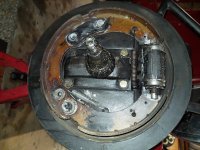I need to overhaul the front brakes of my 1933 ? Buick Speedster, the wheel cylinders are leaking and the drums are oval.
Anyone having an idea what brake system this is?
- 11" x 2" drum with 3" pilot hole (cant find any drum like this in the market)
- 3 brake pad system with the lower pad somehow floating
- unknown wheel cylinder, with no article number, it only states FARA, pat 727. It has a 3 bolt pattern
- backing plate has different hole pattern compared to the usual 1942-1952 Buicks. The hole pattern is 5" x 3"
I looked everywhere for days, but could not find the wheel cylinder or the drum. So I though of changing the entire backing plate and pads, but could not find a backing plate with the correct hole pattern either.
Many thanks in advance
Anyone having an idea what brake system this is?
- 11" x 2" drum with 3" pilot hole (cant find any drum like this in the market)
- 3 brake pad system with the lower pad somehow floating
- unknown wheel cylinder, with no article number, it only states FARA, pat 727. It has a 3 bolt pattern
- backing plate has different hole pattern compared to the usual 1942-1952 Buicks. The hole pattern is 5" x 3"
I looked everywhere for days, but could not find the wheel cylinder or the drum. So I though of changing the entire backing plate and pads, but could not find a backing plate with the correct hole pattern either.
Many thanks in advance

Last edited:

